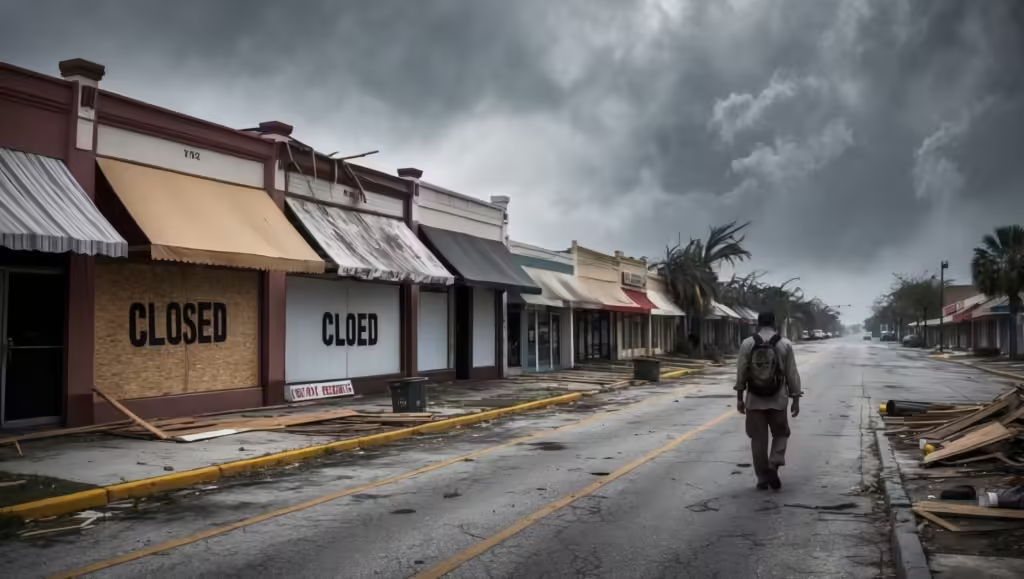
The Dual Financial Impact of Hurricanes: Loss vs. Opportunity
The economic ramifications of Hurricanes Helene and Milton illustrate a striking duality where communities face simultaneous challenges and opportunities. On one hand, the immediate aftermath of these hurricanes is marked by devastating losses, including property damage, disruptions to local businesses, and diminished tourism. Sectors such as real estate, retail, and hospitality often bear the brunt of these storms, with many businesses struggling to stay afloat amidst extensive damage. The inability to operate has lasting effects, leading to reduced income for local workers and an overall decline in regional economic stability.
However, this grim scenario can also unveil unique investment opportunities for certain sectors. Astute investors may recognize that periods of recovery can create advantageous conditions to invest in distressed assets, thereby facilitating long-term growth. The adverse conditions wrought by the hurricanes often lead to increased insurance payouts, government aid, and federal recovery funds, which flow into the affected areas, stimulating economic activity. Investors focusing on sectors such as construction, restoration services, and affordable housing can benefit from this influx of capital, as the demand for rebuilding and repairing damages inevitably rises.
Several anecdotal instances demonstrate how businesses can thrive post-disaster. For instance, a small construction firm in a hurricane-affected area may initially experience a downturn but can pivot towards growth by securing government contracts for rebuilding efforts or by offering services to local homeowners. This business adaptability underscores a critical mindset for investors: viewing adversity not solely as a challenge but as an occasion for innovation and reinvention. Recognizing the potential for economic revitalization can guide strategic investment decisions during these tumultuous recovery periods, paving the way for future profitability amidst the challenging landscape created by the hurricanes.
Recovery Efforts: Strategies and Forecasts for the Year Ahead
The recovery efforts following Hurricanes Helene and Milton have mobilized a comprehensive array of resources at federal, state, and local levels. The Federal Emergency Management Agency (FEMA) has activated disaster relief programs aimed at providing financial aid and assistance for temporary housing, home repairs, and disaster-related medical expenses. Additionally, state agencies are implementing recovery plans that include infrastructure rehabilitation and economic recovery initiatives, focusing on vital areas such as healthcare, education, and public safety.
Nonprofit organizations have also played a critical role in the recovery landscape. These entities are often on the front lines, offering immediate relief in the form of food, clothing, and shelter. Furthermore, nonprofits are engaging in long-term recovery planning, advocating for community rebuilding projects that emphasize sustainable practices. Their flexibility and grassroots approach allow them to address the specific needs of affected areas effectively.
Logistical challenges have arisen during the recovery process, including supply chain disruptions and labor shortages, particularly in the construction sector. To counter these issues, local governments are exploring partnerships with private companies to streamline operations and ensure that resources are deployed efficiently. Technology is also being harnessed to enhance communication among stakeholders and accelerate the collection of data critical for recovery decisions.
Looking ahead to the next year, forecasts indicate a gradual yet steady economic recovery bolstered by targeted investments. Areas most impacted by the hurricanes can expect increased allocations for public infrastructure and housing projects. Successful case studies from past recovery efforts serve as blueprints to navigate the complexities of rebuilding. Notable examples can be found in regions that faced similar challenges, where strategic investments led to economic revitalization and community resilience. Ongoing assessments and the adoption of innovative recovery models will determine not only the timeline of recovery but also the potential for growth as these areas emerge from the aftermath of the hurricanes.
Political Dimensions: Evaluating Election Outcomes and Policy Responses
The aftermath of Hurricanes Helene and Milton has not only caused significant physical destruction but has also necessitated a comprehensive evaluation of the political landscape, particularly in relation to recovery efforts. As the political climate heats up with impending elections, the decisions made by voters will undoubtedly influence the direction of recovery strategies in hurricane-affected communities. The current polling data underscores the importance of understanding which electoral candidates are most aligned with the needs of these populations. Candidates who prioritize policies aimed at disaster relief and climate change mitigation are increasingly viewed as favorable within these communities.
Analyses of candidate platforms reveal varying commitments to addressing immediate needs such as financial aid, housing reconstruction, and essential services restoration. For instance, some candidates propose accelerated funding for disaster relief initiatives, while others focus on creating long-term policies that aim to enhance community resilience against future natural disasters. It is crucial for voters to assess these approaches critically, considering the strengths and weaknesses inherent in each candidate’s plan. Furthermore, the growing awareness of climate change’s impact on severe weather patterns has led to more candidates transparently discussing their strategies for environmental sustainability and climate resilience.
As recovery from the recent hurricanes unfolds, it is essential to recognize that political support can play a pivotal role in shaping effective response frameworks. The integration of climate change considerations within policy proposals signifies a crucial step toward establishing a more robust recovery process. In light of these dynamics, citizens in affected areas must remain informed about the candidates’ positions regarding disaster response and economic recovery initiatives. Engaging with polling data and participating in discussions surrounding candidate proposals will enable voters to understand the potential impacts on their communities in the wake of these significant natural disasters.
Navigating the Aftermath: 10 Steps for Responsible Investing in Affected Areas
Investing in areas affected by natural disasters, such as Hurricanes Helene and Milton, presents unique opportunities for growth and development. However, it is crucial to approach this situation with sensitivity and a commitment to ethical practices. Here are ten steps to ensure that investments not only seek profit but also contribute positively to the community.
1. Conduct Thorough Research: Begin by assessing the specific impacts of the hurricanes on the local economy, infrastructure, and community needs. Understanding the nuances of these challenges helps inform responsible investment decisions.
2. Engage with Local Leaders: Establish relationships with community leaders and organizations. Their insights will provide valuable perspectives on the most pressing needs and opportunities for recovery, ensuring that investments align with local priorities.
3. Participate in Recovery Efforts: Look for opportunities to support ongoing recovery projects. Aligning investments with local rebuilding efforts strengthens community ties and enhances the potential for lasting impact.
4. Prioritize Sustainable Practices: Choose investments that incorporate sustainable practices, benefiting the environment while supporting economic growth. This commitment resonates with local populations keen on long-term recovery.
5. Foster Community Involvement: Encourage resident participation in investment initiatives. This can include advisory panels or focus groups, ensuring that community voices are heard and considered in decision-making processes.
6. Focus on Infrastructure Development: Invest in projects that enhance local infrastructure, such as housing, transportation, and utilities. Strengthening these areas can help communities recover and thrive in the wake of disaster.
7. Build Long-Term Relationships: Invest with an eye toward building long-term partnerships with local businesses and organizations, creating opportunities that transcend short-term profit motives.
8. Assess Social Impact: Regularly evaluate the social impact of your investments. Measure the benefits to the community and adjust strategies to maximize positive outcomes while minimizing any unintended consequences.
9. Advocate for Local Employment: Support initiatives that create jobs for residents. Employment opportunities are crucial for community recovery, encouraging economic growth and stability.
10. Commit to Ethical Practices: Adhere to ethical investment principles, avoiding any actions that exploit the vulnerable state of the community. Uphold transparency and integrity in all dealings to foster trust and collaboration.
These steps, when implemented thoughtfully, can help investors navigate the aftermath of Hurricanes Helene and Milton with a focus on responsibility and community support, ultimately leading to sustainable development that benefits all stakeholders involved.
